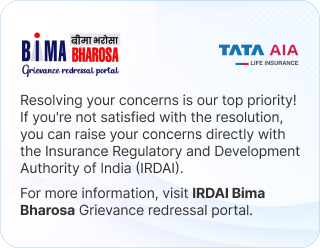A Unit Linked Life Insurance Plan (ULIP) is a good insurance investment option to consider for your portfolio. It combines the benefits of two different financial products—life insurance and wealth creation investments. A ULIP plan allocates a portion of the premium paid by the policyholder as the premium for the life insurance policy, and the remaining is invested in a fund of the policyholder’s choice to meet their financial goals.
From a long-term perspective, a ULIP policy is a prudent policy because it also enables tax* savings in addition to the dual benefits. ULIPs offer other advantages such as partial withdrawals. The partial withdrawal option comes in handy when you unexpectedly need a chunk of money. But it is important to understand how partial withdrawals work in ULIPs, and how to opt for them wisely when required.
Can You Withdraw Funds from ULIP Before Maturity?
No, you cannot withdraw funds from a ULIP before completing the mandatory 5-year lock-in period. Here are the main points to know:
- Lock-in period: Withdrawals are allowed only after the first five years of the policy.
- Minimum balance: Some insurers require you to maintain a minimum fund balance even after making a withdrawal.
- Withdrawal limit: The amount you can withdraw depends on the insurer’s terms and the specific policy conditions.
- Effect on life cover: Taking out funds may reduce the sum assured (your life cover amount).
- Age limits: Certain policies may have age-related restrictions on withdrawals.
Number of withdrawals: Insurers often limit the number of free withdrawals you can make during the policy term.
When Can We Withdraw from ULIP?
After completing the 5-year lock-in period, policyholders can make partial withdrawals from their ULIP funds. As per the IRDAI guidelines, the frequency of withdrawals depends on the options provided by the insurer, it may be monthly, quarterly, half-yearly, or yearly.
What is the Lock-in Period for ULIP?
Partial withdrawals in ULIP are possible only after the lock-in period of your policy ends. The maturity period of your ULIP policy may be 20 or 30 years. However, the lock-in period for all ULIP plans is five years. This lock-in period is related to the money invested in funds. The lock-in period is devised to boost your fund value. Typically, your fund value begins to rise only after you pay the initial few premiums on your ULIP policy. Also, the longer your investment horizon, the better it is for your returns and for hedging market risks.
Is it Possible to Withdraw Funds Before the Lock-in Period?
You cannot make partial withdrawals during the lock-in period of five years. There’s no way around it. Even if you choose to surrender your ULIP policy or discontinue it, you still won’t be able to access your money until the end of the lock-in period.
When you surrender your ULIP plan, the risk cover will cease to exist, but you still will have to wait to receive the money. It is also essential to note that the partial withdrawal facility is only available to those who have paid all the premiums due, and the ULIP policy is in force.
How Much Amount is Allowed for Partial Withdrawals?
When partially withdrawing from your ULIP plan, you can withdraw either ₹ 1,000 or ₹ 2,000 as the minimum amount, depending on your policy. As for the maximum limit, it is around 25% of your fund’s value at the time of withdrawal. This is subject to the condition that at least one year’s premium remains in the fund.
For instance, say a policyholder bought a ULIP policy, which after the lock-in period of five years has a fund value of ₹ 3 Lakh. The annual premium is ₹ 50,000, and the sum assured is ₹ 6 Lakh. 25% of the fund value, in this case, amounts to ₹ 75,000. On withdrawing ₹ 75,000, because the amount equal to one year’s premium (₹ 50,000) remains in the fund, it is possible to make a partial withdrawal for ₹ 75,000.
What is the Impact on the Sum Assured?
When you withdraw from your ULIP fund, not only does the fund value decrease by that amount but also the sum assured.
However, this reduction in the sum assured is only for a period of two years. At the end of the two years, the sum assured will automatically be restored to the original amount. So in the long term, making a partial withdrawal will not have a negative impact on your ULIP policy.
It is important to remember that this automatic restoration of the sum assured is only possible if you don’t make any additional withdrawals within the two-year period. Another requirement is that you continue paying the premiums due.
Hence, the only situation in which making a partial withdrawal in ULIP will have a lasting impact is if the policyholder passes away during the two-year period after the withdrawal. In that case, the reduced sum assured will be paid to the nominee.
Conclusion
The partial withdrawal facility is certainly a useful feature of ULIP funds. It can be a blessing during financial emergencies. However, before making a partial withdrawal, you should consider the impact on your ULIP funds and the sum assured.
L&C/Advt/2021/Sep/1572











 FOR EXISTING POLICY
FOR EXISTING POLICY 
 FOR NEW POLICY
FOR NEW POLICY 








